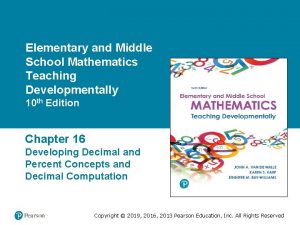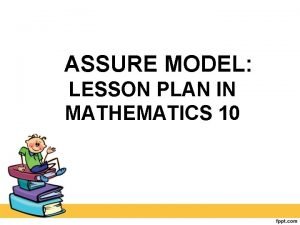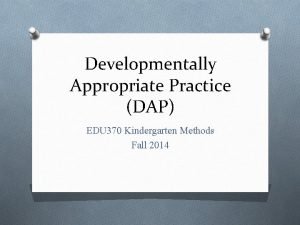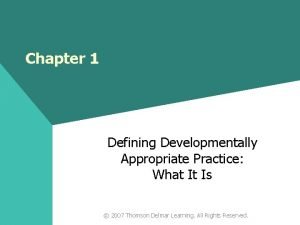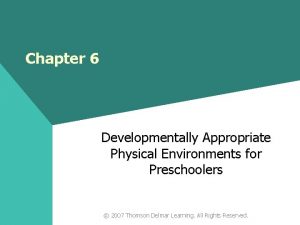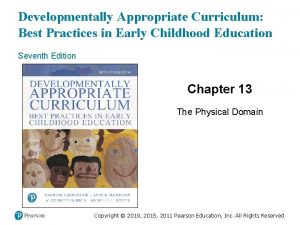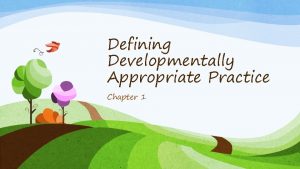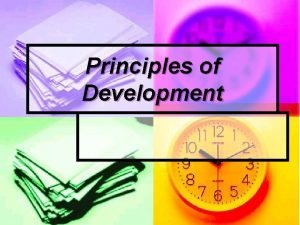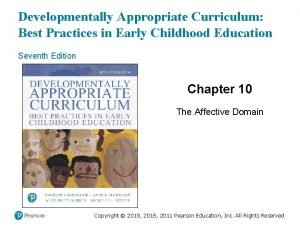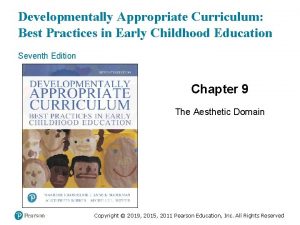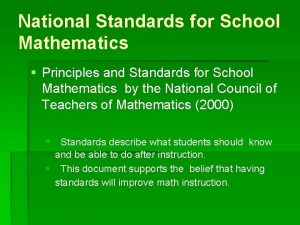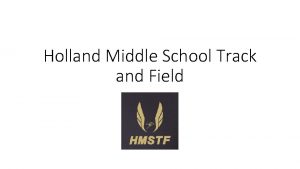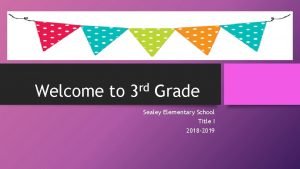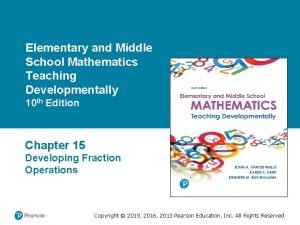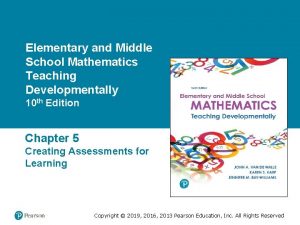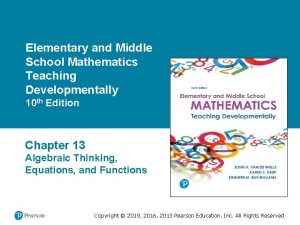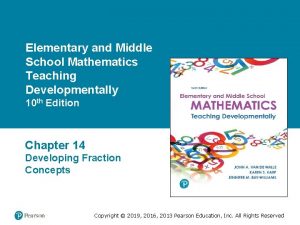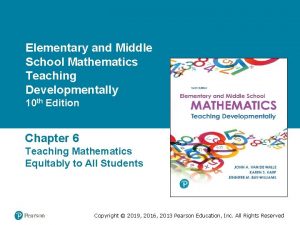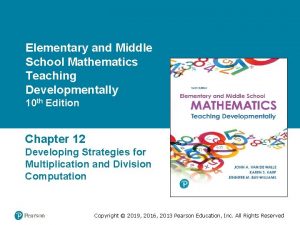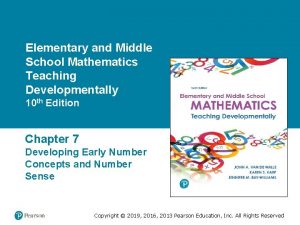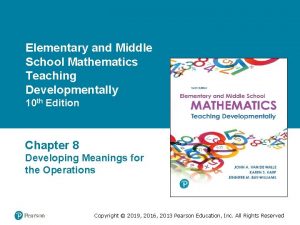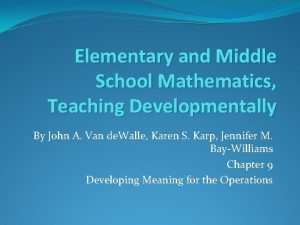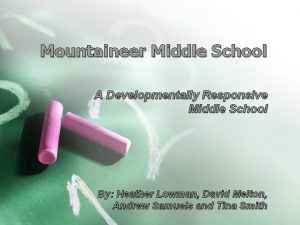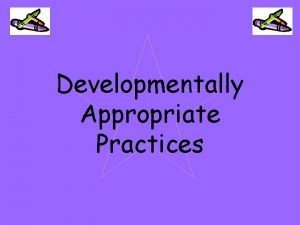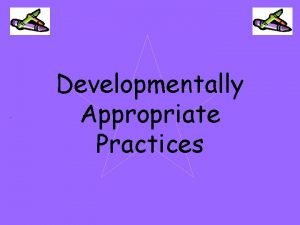Elementary and Middle School Mathematics Teaching Developmentally 10




















- Slides: 20

Elementary and Middle School Mathematics Teaching Developmentally 10 th Edition Chapter 10 Developing Whole-Number Place-Value Concepts Copyright © 2019, 2016, 2013 Pearson Education, Inc. All Rights Reserved

Learner Outcomes (1 of 2) 10. 1 Identify the pre-base-ten understandings based on a count-by-ones approach to quantity. 10. 2 Recognize the foundational ideas of place value as an integration of three components: base-ten concepts through groupings and counting, numbers written in place-value notation, and numbers that are spoken aloud. 10. 3 Demonstrate how to develop students’ skills in place value through the use of base-ten models. 10. 4 Explain how students can use grouping activities to deepen their understanding of place-value concepts. Copyright © 2019, 2016, 2013 Pearson Education, Inc. All Rights Reserved

Learner Outcomes (2 of 2) 10. 5 Explain strategies to support students’ ability to write and read numbers. 10. 6 Recognize that there are patterns in our number system that provide the foundation for computational strategies. 10. 7 Describe how the place-value system extends to large numbers. Copyright © 2019, 2016, 2013 Pearson Education, Inc. All Rights Reserved

Pre-Place-Value Understandings Children’s pre-place-value view of number Ask first or second-graders to count out 53 tiles. Watch closely to note whether they count out the tiles one at a time or push put them into a pile without any type of grouping or if they group them into tens. Have the students write the number that tells how many tiles they just counted. You will likely find that early on, students count the tiles one by one and are not thinking of ten as a unit and are therefore in a pre-place-value stage. Copyright © 2019, 2016, 2013 Pearson Education, Inc. All Rights Reserved

Three Stages of the Grouping of 53 Objects Grouping Stage Visual Representation Counting Approach Students Can: Unitary Count by ones 1 group of many dots, scattered without pattern. 1, 2, 3, 4, 5, 6, 7, 8, 9, 10, 11, and so on Name a quantity or “tell how many” by counting each piece. Are not yet able to think of 10 as a single unit. Use counting by ones as the only way they are convinced that different sets have the same amount. Base Ten Count by groups of tens and ones 5 groups of 10 dots each, and 3 single dots. Equivalent Nonstandard base ten There are 3 groups of 10 dots, and a group of many dots, scattered. 1, 2, 3, 4, 5 groups of 10 and 1, 2, 3, ones (singles) or 10, 20, 30, 40, 51, 52, 53 Count a group of 10 objects as a single item (unitizing). Before counting students would trade and then count 10, 20, 30, 40, 51, 52, 53 Group the pieces flexibly into versions that include tens and ones but all trades have not been carried out. Coordinate the base-ten approach with a count by ones to as a means of telling “how many. ” Use these alternate groupings to relate to computation by being able to trading or regroup numbers in a variety of ways. Copyright © 2019, 2016, 2013 Pearson Education, Inc. All Rights Reserved

Integrating Base-Ten Groupings with Words Groupings of ten matched with numerals Numerals put in place value - Use base-ten language Written in standard form Copyright © 2019, 2016, 2013 Pearson Education, Inc. All Rights Reserved

Integrating Base-Value Grouping with Place Value Notation Copyright © 2019, 2016, 2013 Pearson Education, Inc. All Rights Reserved

Base-Ten Models for Place Value Groupable base-ten models Pregrouped base-ten models Copyright © 2019, 2016, 2013 Pearson Education, Inc. All Rights Reserved

Activities to Develop Base-Ten Concepts Copyright © 2019, 2016, 2013 Pearson Education, Inc. All Rights Reserved

Activity 10. 4 Too Many to Count? Grouping Tens to Make 100 Materials-Any quantity with 150 to 1000 items e. g. large a bag of toothpicks, buttons, beans, plastic chips, straws, craft sticks Directions: • Make and record estimates of how many items are in the jar, bag, box etc. • Discuss how they determined their estimates. • Distribute portions of the items to groups to count (provide cups, plastic bags or rubber bands). • Collect leftovers and put them in groups of ten. • Now ask, “How can we use these groups of ten to tell how many items we have? ” “Can we make new groups of ten? ” What is 10 groups of ten called? ” Copyright © 2019, 2016, 2013 Pearson Education, Inc. All Rights Reserved

Activity 10. 7 Base-Ten Riddles Equivalent Representation Materials – Base-Ten Riddle Cards - Present the riddles orally or written. • I have 23 ones and 4 tens. Who am I ? • I have 4 hundreds, 12 tens and 6 ones. Who am I? • I have 30 ones and 3 hundreds. Who am I? • I am 45. I have 25 ones. How many tens do I have? • I am 341. I have 22 tens. How many hundreds do I have? • If you put 3 more tens with me, I would be 115. Who am I? • I have 17 ones. I am between 40 and 50. How many tens do I have? Have students write new riddles. Copyright © 2019, 2016, 2013 Pearson Education, Inc. All Rights Reserved

Reading and Writing Numbers (1 of 2) Copyright © 2019, 2016, 2013 Pearson Education, Inc. All Rights Reserved

Reading and Writing Numbers (2 of 2) The use of place value mats provides and method for children to organize their materials. Two ten frames in the ones place help eliminate the repeated counting of ones. Copyright © 2019, 2016, 2013 Pearson Education, Inc. All Rights Reserved

Five Levels of Place Value Understanding 1. Single numeral. The student writes 36 but views it as a single numeral. The individual digits 3 and 6 have no meaning by themselves. 2. Position names. The student correctly identifies the tens and ones positions but still makes no connections between the individual digits and the blocks. 3. Face value. The student matches 6 blocks with the 6 and 3 blocks with the 3. 4. Transition to place value. The 6 is matched with 6 blocks and the 3 with the remaining 30 blocks but not as 3 groups of 10. 5. Full understanding. The 3 is correlated with 3 groups of ten blocks and the 6 with 6 single blocks. Copyright © 2019, 2016, 2013 Pearson Education, Inc. All Rights Reserved

Place Value Patterns and Relationships A Foundation for Computation • The hundreds chart is an important tool in development of place value. • Recognizing place-value related patterns • Relationships with landmark numbers • Number relationships for addition and subtraction Copyright © 2019, 2016, 2013 Pearson Education, Inc. All Rights Reserved

Relative Magnitude Using Benchmark Numbers Activity 10. 17 Who Am I? Materials - A long line on a strip of paper and labeled 0 and 100 Directions: Mark a point with a ? that corresponds with your secret number. Have students try to guess and label and mark that number on the line until your secret number is discovered. Variations. End points can be different 0 to 1000, 200 to 300, 500 to 800 Copyright © 2019, 2016, 2013 Pearson Education, Inc. All Rights Reserved

Connections to Real-World Ideas Encourage students to notice numbers in the world around them. Where are numbers used in this school? • Number of third graders • Number of minutes devoted to mathematics each week • Number of days since school started • Number of cartons of chocolate or plain milk sold in the cafeteria What do you do with these numbers? Copyright © 2019, 2016, 2013 Pearson Education, Inc. All Rights Reserved

Numbers Beyond 1000 • Multiplicative structure of number- ten in any position makes a single thing (group) in the next position to the left • Conceptualizing large numbers • Reading numbers in triples and then naming the unit (don’t use the word and, which is reserved for the decimal point) Copyright © 2019, 2016, 2013 Pearson Education, Inc. All Rights Reserved

Common Errors and Misconceptions in Place Value (1 of 2) Misconception/ Error What It Looks Like How to Help Students lose track of the fact that each digit in a multidigit numeral carries a value dependent on its position in the number. When students are asked to compare the numbers (2) bolded in the two amounts that follow they will say they are the same. Use Base-Ten Materials and have student show with materials the value of these two numbers. The reading of numbers in addition or subtraction problems as digits (saying 5 instead of 5 tens or fifty) confuses students. 2357 and 49, 992. Students hear numbers like 2, 357 read as two, three, five, seven—when they should always be read two thousand, three hundred, fifty-seven. Use the place value cards discussed previously to reinforce how numbers are built. Use the digit correspondence task described in this chapter to identify which of the five levels of understanding matches your student’s performance. Reinforce that the value of an individual digit in a multidigit number is the product of that digit multiplied by the value assigned to its position in the number Copyright © 2019, 2016, 2013 Pearson Education, Inc. All Rights Reserved

Common Errors and Misconceptions in Place Value (2 of 2) 1. Students reverse the digits when writing two-digit numbers. 2. Students represent a number with base-ten materials using the face value of digits. 3. Students put the word “and” in a number word when they read it aloud. 4. Students use a form of “expanded number writing”. 5. When shown a collection base-ten materials where there is an internal zero the students ignore the zero or misunderstand the zero. 6. If students are given the place values of numbers out of order, they write the number as given left to right regardless of the place value. 7. Students misinterpret the value of base-ten materials. Copyright © 2019, 2016, 2013 Pearson Education, Inc. All Rights Reserved
 Elementary and middle school mathematics 10th edition
Elementary and middle school mathematics 10th edition Detroit public schools
Detroit public schools Assure model lesson plan example
Assure model lesson plan example Kindergarten uniform japan
Kindergarten uniform japan Aims are
Aims are Example of teacher dominated approach
Example of teacher dominated approach Definitions of microteaching
Definitions of microteaching Developmentally appropriate practice for kindergarten
Developmentally appropriate practice for kindergarten Developmentally appropriate practice meaning
Developmentally appropriate practice meaning Developmentally appropriate environment
Developmentally appropriate environment Developmentally appropriate curriculum 7th edition
Developmentally appropriate curriculum 7th edition Define developmentally appropriate practice
Define developmentally appropriate practice Development occurs in a relatively orderly sequence
Development occurs in a relatively orderly sequence Developmentally appropriate curriculum 7th edition
Developmentally appropriate curriculum 7th edition Developmentally appropriate curriculum 7th edition
Developmentally appropriate curriculum 7th edition Principles and standards for school mathematics
Principles and standards for school mathematics Holland middle school track
Holland middle school track Ubujan elementary school
Ubujan elementary school Family portal schoolmax
Family portal schoolmax Mackay elementary school tenafly
Mackay elementary school tenafly Sealey elementary
Sealey elementary
